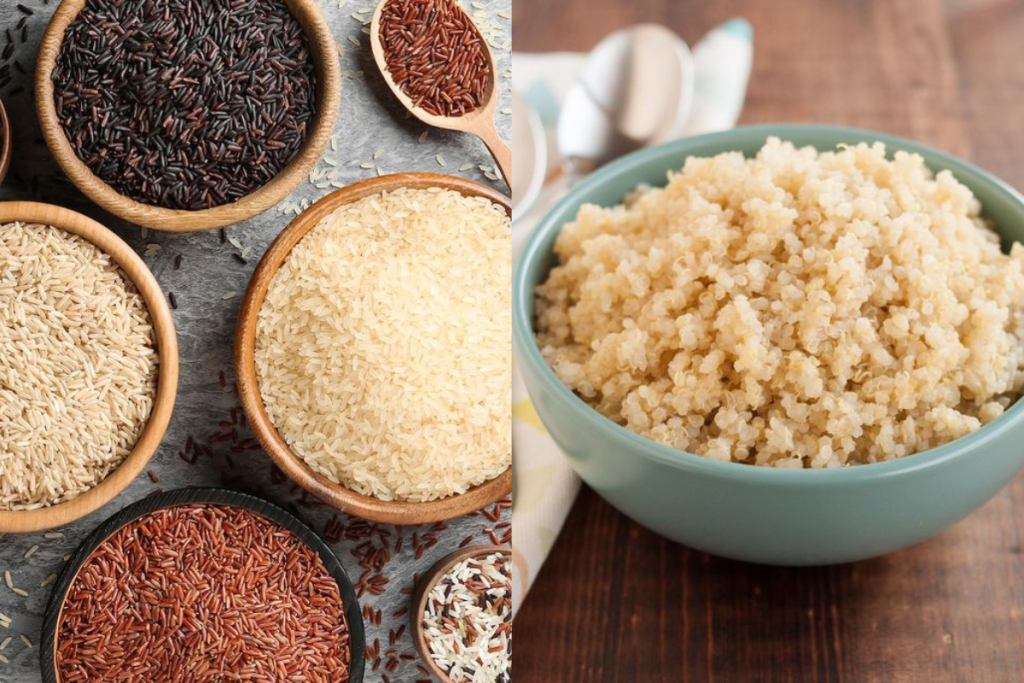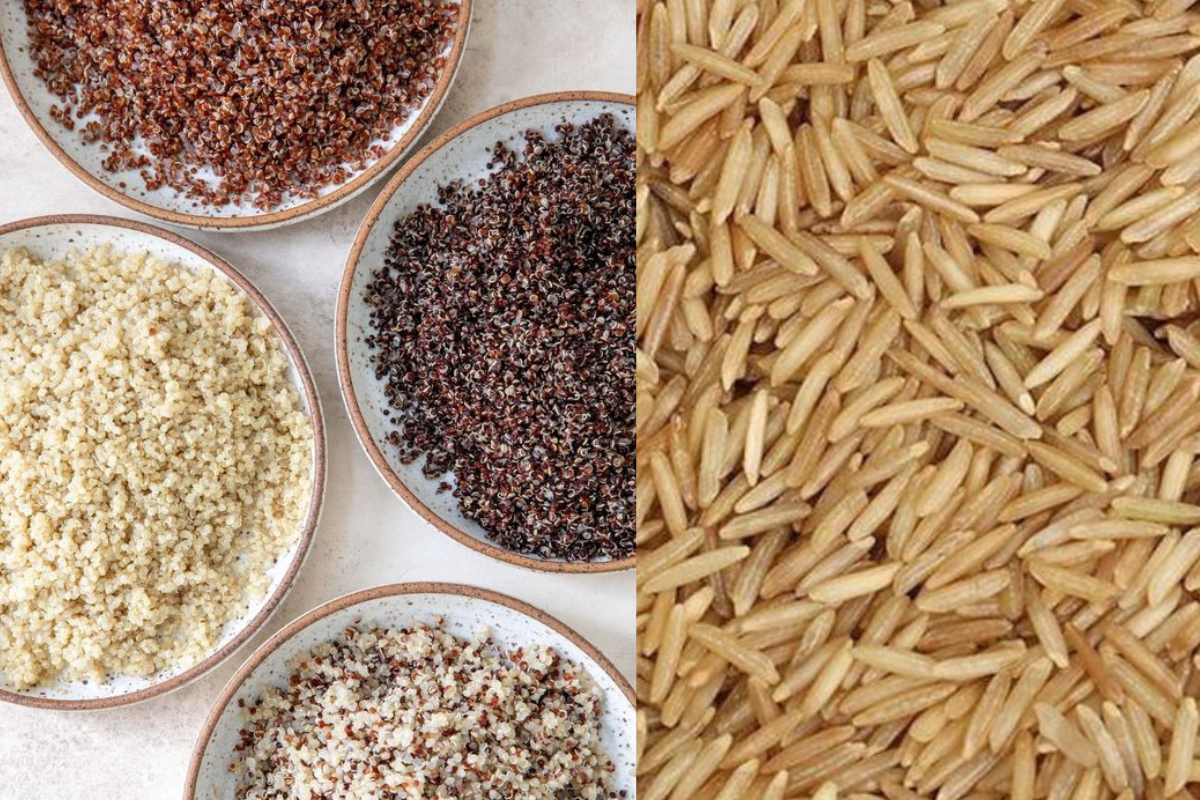When it comes to healthy grains, quinoa and brown rice are often compared for their nutritional benefits, weight loss potential, and versatility in cooking. While both have a place in balanced diets, they differ in key aspects, from their nutrient profiles to their environmental impact. In this guide, we’ll explore the differences between quinoa and brown rice, helping you make an informed decision about which is the best fit for your lifestyle.
Nutritional Showdown: Quinoa vs. Brown Rice
Quinoa is often celebrated as a “superfood” due to its impressive nutrient content. It is a complete protein, meaning it contains all nine essential amino acids, making it especially valuable for vegetarians and vegans. Quinoa is also rich in fiber, magnesium, iron, and B vitamins. Meanwhile, brown rice is a whole grain with a nutty flavor, offering fewer proteins but packing a good amount of manganese, selenium, and fiber.
| Nutrient | Quinoa (Cooked, 100g) | Brown Rice (Cooked, 100g) |
|---|---|---|
| Calories | 120 kcal | 123 kcal |
| Protein | 4.1 g | 2.6 g |
| Fat | 1.9 g | 0.9 g |
| Carbohydrates | 21 g | 25 g |
| Fiber | 2.8 g | 1.8 g |
| Iron | 1.5 mg | 0.8 mg |
| Calcium | 17 mg | 10 mg |
Key Takeaways:
- Quinoa: Higher in protein and fiber, making it great for muscle building and digestion. It’s also rich in magnesium and iron.
- Brown Rice: Provides more carbohydrates but is slightly lower in protein and fiber. However, it’s a great source of manganese and selenium.
Weight Loss: Quinoa or Brown Rice?
Both quinoa and brown rice can be part of a weight loss diet, but quinoa may have a slight edge due to its higher protein and fiber content, which helps promote satiety. Quinoa’s lower glycemic index (53) means it has a slower impact on blood sugar, helping to regulate hunger. Brown rice has a higher glycemic index (68), which could result in quicker spikes in blood sugar.
For those focusing on weight loss, the extra protein in quinoa can aid in maintaining muscle mass while losing fat. The fiber in both grains can also help reduce cravings and overeating.
Health Benefits: Quinoa vs. Brown Rice
Both grains offer a wide range of health benefits:
Quinoa:
- Complete Protein: Quinoa is one of the few plant-based foods that contain all essential amino acids, making it ideal for those on plant-based diets.
- Low Glycemic Index: Helps regulate blood sugar, making quinoa a great choice for people with diabetes or those looking to stabilize energy levels.
- High in Antioxidants: Quinoa contains antioxidants like quercetin and kaempferol, which help reduce inflammation.
Brown Rice:
- Heart Health: Brown rice is rich in manganese and selenium, which are crucial for heart and thyroid health.
- Rich in Fiber: The fiber content promotes digestive health, supports gut function, and helps prevent constipation.
- Lower Cholesterol: Regular consumption of brown rice has been linked to improved cholesterol levels.
Cooking and Preparation
Quinoa and brown rice both require slightly different preparation methods:
Quinoa cooks faster, in about 15-20 minutes with a 2:1 water-to-quinoa ratio. It’s important to rinse quinoa before cooking to remove its bitter saponin coating.
Brown Rice takes longer to cook, about 45-50 minutes, with a 2.5:1 water-to-rice ratio. While it’s chewier than white rice, the extra cooking time is often worth it for its nutty flavor and satisfying texture.
Both grains can be used in a wide variety of dishes, including salads, stir-fries, soups, and side dishes. Quinoa also works well in breakfast bowls or as a stuffing for vegetables.

On the topic:
Zucchini vs. Squash: What’s the Difference, and Why You Should Care!
Cabbage vs. Lettuce: The Leafy Green Face-off!
Oat Milk vs Almond Milk: The Ultimate Showdown
Environmental Impact: Sustainability Considerations
The environmental impact of quinoa and brown rice differs:
- Quinoa is primarily grown in the Andean region, and the surge in global demand has led to both positive and negative effects for local farmers. While quinoa is a resilient crop that can grow in harsh conditions, over-farming can lead to soil depletion.
- Brown Rice, typically grown in water-intensive conditions, especially in Asia, has a larger environmental footprint. Rice farming produces significant amounts of methane, a potent greenhouse gas, though sustainable farming methods are emerging to reduce this impact.
Choosing organic, sustainably sourced options for both quinoa and brown rice can help reduce their environmental effects.
FAQ: Quinoa vs. Brown Rice
Is quinoa healthier than brown rice?
In terms of protein and nutrient density, quinoa is generally considered healthier. It’s a complete protein and contains more fiber, magnesium, and iron than brown rice.
Should I eat rice or quinoa for weight loss?
Quinoa is slightly better for weight loss due to its higher protein and fiber content, which can help you feel fuller for longer.
Can I eat quinoa every day?
Yes! Quinoa is a nutrient-rich food that can be eaten daily as part of a balanced diet. However, variety in your diet is key to ensuring you get a wide range of nutrients.
Is quinoa better than basmati rice?
Quinoa generally offers more protein and fiber than basmati rice, making it the better option nutritionally. However, basmati rice has a lower glycemic index than other white rice varieties, making it a decent option for controlled blood sugar.
How do quinoa and brown rice compare in calories?
Both quinoa and brown rice are similar in calories, with quinoa slightly lower at 120 kcal per 100g and brown rice at 123 kcal per 100g cooked.
Which is better for diabetics: quinoa or brown rice?
Quinoa has a lower glycemic index than brown rice, meaning it has a lesser impact on blood sugar levels, making it a better choice for diabetics.
What are the differences between quinoa, brown rice, and white rice?
White rice is the most processed and has the least nutritional value, while quinoa is the most nutrient-dense with complete proteins and fiber. Brown rice is a middle-ground, offering more nutrients than white rice but less than quinoa.
Conclusion
Both quinoa and brown rice bring valuable nutrients to the table, but they serve different roles. If you’re looking for a complete protein with higher fiber and faster cooking time, quinoa is the winner. However, if you prefer a whole grain with a chewier texture and heart-healthy minerals, brown rice is an excellent choice.
Ultimately, the decision between quinoa and brown rice depends on your specific dietary needs, preferences, and environmental considerations.

